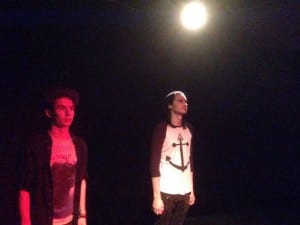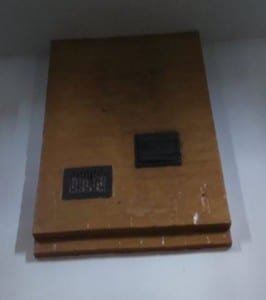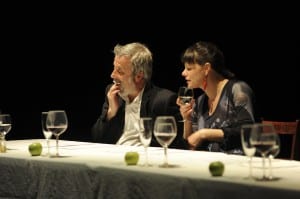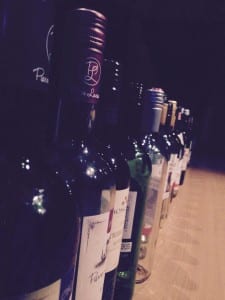
Framing Communion
“I can take an empty space and call it a bare stage…[spontaneity] destroys in one blow many deadly forms, like the dreariness of theatre buildings, and the charmless trappings of curtain” (Brooke, 1996).
Perhaps it is easiest to describe Communion as a site-specific performance and installation that took place at the Lincoln Drill Hall, in ‘the room upstairs’, over a course of five hours (in fifteen minute intervals) on the 4th May 2016. However, one cannot help but feel, for all intents and purposes, that this frank description is a horrid over-simplification, as Communion, from its inception all the way to its final form, has become so much more. Our piece aimed to connect the audience to the historical context of ‘the room upstairs’ through themes and actions such as drinking, remembrance, war and psychological trauma. Indeed, our site was once a ‘gentleman’s club’ for officers during the First World War, a place for them to supress the horrors of war and conflict, to drink, to forget. We wanted to take our audience on a journey, not necessarily a physical one, but one of emotion, contextualised through the history of the space. In the end, the piece consisted of a single audience member being blindfolded and, with their hand on one performer’s (the guide’s) shoulder, led up to ‘the room upstairs’ by means of the lift. Once there, the performer lead the audience member to our main installation, a long table with wine bottles laid out on the floor to tunnel their vison and focus, and the blindfold was removed. From there, they were offered a seat by the second performer sat across the table from them, and invited to ponder over wine and what importance drinking had not only to the historical context of the space, but within the audience member’s own life. After a toast, the audience member was led by the guide to the second half of the space and, therefore, the secondary half of the performance. The audience member would then sit and watch as the third performer (myself) began to submerge their hand in earth taken from the common; slowly both wine and crushed grapes would be added to the earth, and consequently the third performer’s hand would became covered in mud, ending with them moving towards and entering the toilet. The guide then suggested the audience member goes and assists the third performer in the washing of the hand and, with the door being closed behind them, the audience member entered the toilet. Once inside, the third performer would ask the audience member to assist in washing their hands by turning on the tap and physically assisting by scrubbing the hands of the third performer. When these actions were completed, the third performer handed over a single chocolate coin and the audience member was lead out of the space.
The performance lasted ten to fifteen minutes on average each time, which allowed a certain development and consistency within the piece, as more wine was drank and the earth and wine concoction became more stagnant and putrid. Theatrical convention within Communion was turned on its head, subverted in such a way that a single audience member would have a personal experience and emotional journey with the piece. Whilst we aimed to make the audience forget that the space was indeed designed for use in theatrical performance, we never overtly hid that fact either, with us employing the already existing lighting rig to highlight certain parts of the space and our use of the flats to tunnel the audience member’s perspective, connecting and ultimately juxtaposing the modern uses of the space with its past ones. In regards to inspiration for Communion, the piece drew heavily from The Last Supper (2004) by Reckless Sleepers, mostly in an aesthetic sense, and the teachings of Peter Brooke in his book The Empty Space.
A journey through Communion – the creative process
In his book Site-Specific Performance, Mike Pearson frequently references ‘site’ and ‘place’ as having an interesting ‘fluidity’ (Pearson, 2010). In essence, and in terms of Communion as a performance piece, Pearson’s description of site-specific performance strikes astounding resonance. Whist we began with certain ideas and themes that the piece should explore and represent, something strange and interesting began to happen throughout the creative process. As we performed and tested the piece in its various forms, we found the piece began to suggest certain themes and ideas to us that we had not been aware of. This, indeed, is where the idea of the piece exploring post-traumatic stress came into existence, as I found that my part in the performance (the mixing of earth with wine and grapes along with the desperate and constant washing of hands) ultimately embodied that theme. My part in the performance became an extension of the second performers, an ethereal representation of the thoughts and emotions the officers of the ‘gentleman’s club’ were trying desperately to keep at bay through drinking to forget. The intriguing part of this development, of course, was that this idea was dictated to us by the piece itself, not from our own perceptions of the piece and space. Considering one of our aims was to challenge an audience member’s perceptions of regular theatrical space and conventions, the piece having the same effect on its performers adds an interesting, almost meta-theatrical, angle to the piece, transcending the guidelines and restrictions of conventional ‘theatre’.
Drifting and Non-spaces
Employing Phil Smith’s guide to Mythogeography (Smith, 2010), and his ‘drifting’ activity, we began by simply taking in the space in, wandering round it without any preconceived goal. This allowed us to see past the Drill Hall’s ‘psycho-geography’ as a theatre, and forced us to not view ‘the room upstairs’ as a studio space, but something more, linked with the officers of the First World War. Whilst it was indeed difficult to see the space for anything but its modern studio use at first, eventually the space began to reveal its secrets to us. Through ‘drifting’, we noticed a preserved section of a nicotine-stained wall at the top of the room. It hung there, a solemn reminder of what once was. This ‘non-space’ was evident of a time before, a part of the ‘gentlemen’s club’ that we wanted to make apparent in our piece. We decided a substantial part of the piece should take place underneath this stained wall, it only seemed fitting. In the final performance, this unknown part of the piece was the mixing of earth from the common with wine and grapes, a task desperately done in the presence of this nicotine-stained part of the ‘gentlemen’s club’.


The toilet was another place we noticed and it interested us. Another ‘non-space’, its intimate nature is indeed what struck us. After doing research into one-to-one performances, we came across Adrian Howells’ Foot Washing for the Sole (2010); a piece that included physical contact between audience and performer through the act of washing. Using this, we began to suggest that perhaps an audience member could help me wash my hand in the sink, adding to this innate intimacy that the space had. We believed this could serve as representation for soldiers after war needing support. When one takes into account the idea of post-traumatic stress disorder, this becomes massively relevant, linking this action back to the historical context. Additionally, as soon as the toilet became a space we were to employ in the piece, I suggest that, after the audience member had assisted in the washing of the hands, I would give them a single coin, as a payment almost. The reasons I had for this were simply that we assumed that, due to the space being described as a ‘gentleman’s club’, perhaps more than just drinking went on there, with the officers seeking the pleasures of ‘ladies of the night’, if you will. Whilst we cannot be certain these activities certainly happened, I believed it would indefinitely add to the already quite intimate situation of an audience member and a performer in a cramped toilet, and add a certain uncomfortable tinge to that part of the piece. The simple act of payment for services in such a space and context naturally has uncomfortable connotations, whether from the obvious links to prostitution or the act of dealing with a person with post-traumatic stress disorder.
Inspiration from Reckless Sleepers

As previously mentioned, Communion took aesthetic inspiration from The Last Supper by Reckless Sleepers, employing a long table at the centre of the main installation, giving the space the focus we wanted. Also, less importantly, both The Last Supper and Communion, have certain religious connotations, the former in name and the latter in both name and the extensive use of wine.
Lincolnshire Archive Research
Documents we found from the archives proved the existence of this ‘gentlemen’s club’ in ‘the room upstairs’, in the form of a book that kept track of budgetary meetings.
We found also that, on the days we went to the Drill Hall, ‘the room upstairs’ was booked out before us for ‘Hartbeeps’, an interactive class for toddlers and children. We found this contrast between the children-orientated classes and the smoke-filled room of the ‘gentleman’s club’ interesting. Our first idea was to show this juxtaposition through the installation, using whiskey tumblers filled with milk and milk bottles filled with whiskey and wine and children’s toys hung up around the space. We, as performers, would be waiters, serving audience members at tables, and fake money would be piled on the tables to link back to the budget meeting documents we had found. Alas, soon after this idea had come, we realised that we were trying to represents too much and, after advice from the module co-ordinator, we put the idea of the children’s class aside to focus more on the wine itself.
On the use and collection of wine bottles
Just as a personal note, I think it is safe to say that I do not wish to see, smell or touch another wine bottle for a very long time. My sudden distaste for wine and its containers may interest and confuse some, so an explanation is in order. Our original plan was to fill all of the first half of ‘the room upstairs’ with wine bottles, both linking to the space’s use as a ‘gentleman’s club’ and creating a sensory spectacle for an audience member. However, we over-estimated the amount of bottles this would take. After testing and laying out two hundred to three hundred bottles, we realised it would be impossible in the time frame to gather the necessary amount of bottles to adequately fill the space (we would have need over a thousand at least). After meeting with the module co-ordinator and our tutor to discuss this problem, it was suggested to us that we simplify our installation, focusing mostly on the amount of wine that had been drunk in the space.
Below is a short recording meeting we had to discuss other ways of creating an installation using the wine bottles:
(Anthony and Kay, 2016)
By chance, when setting out the wine bottles, we began to see the shape of a wine bottle being formed around the table on the floor. This, we believe, added to the focus of the piece, forcing an audience member to tunnel their vison to specific parts of the space. From doing this, we had constructed “another architecture within the existing architecture…which confounds everyday hierarchies of place and pattern of movements” (Pearson, 2010, 36). This pathway of wine bottles served to aid the audience member through the piece, and by lining bottles on the table, we added to the tunnelling and focusing of their vision.

The role of the audience
When we decided to start focusing on the role of the audience in Communion, we began with the idea of having numerous audience members at a time. However, due to the guiding and focused nature of the piece, we quickly decided on having only one audience member at a time, as it made sense to add to the intimate and personal feel we were trying to achieve. Many aspects of Communion, including the audience member drinking wine at the table and them assisting the performer in the toilet in washing their hands, relied on the audience member participating. We discussed the effects this could have on the piece, as “participation in the performance event often triggers spontaneity, improvisation…and a willingness to partake” (Zerihan, 2009, 3). This spontaneity would add to the personal experience of each audience member, effectively creating a slightly different performance for every individual audience member.
Performance Evaluation
Our piece ran from 12:15pm to 5pm on the day of performance. Due to setting up time being longer than expected, we started fifteen minutes later than planned. Despite this early setback, our piece was unexpectedly popular, with all but three slots, including the one we missed at the beginning, being filled, with us performing the piece seventeen times. The flow of the piece over the five hours was more or less consistent, with the only break being around 3pm. I feel this only strengthened the consistency of the piece, although we were unable to practise with an audience member prior, so the constant flow of audience members was more challenging than we had anticipated. We kept the length of each at fifteen minutes, further added to the consistency we strived for.
Audience feedback was particularly positive, with many highlighting the visual spectacle of the wine bottle installation. Also many spoke with me after in regard to the section of the piece within the toilet, their emotions ranging from pity and sadness to uncomfortable and quite awkward. One woman even said that she felt a strange sense of shame after I handed her a coin as payment for the assistance in the washing of hands. The vast range of emotions felt by different audience members leads me to believe the toilet section was successful, giving each audience member a personal, unique experience. Reflecting on that, it would have been beneficial to test the piece on audience members prior to the final performances, which would have perhaps given me more confidence with audience members from the very first performance, instead of gaining it after the first few.
Whilst the dialogue in the piece did vary from performance to performance, the spontaneous nature of allowing an audience member to react in any way they want required a sense of looseness and improvisation in the dialogue, to allow the piece to flow smoothly. For example, the second performer’s instructions for the audience member to “open their eyes” and “pick up your glass” (Anthony et al, 2016) was only spoken if the audience member had not done these actions, and only included to push vital parts of the piece forward.
Upon reflection, my foray in site-specific performance and art has been a journey of discovery and realisation. As a group of performers, we felt genuinely engaged with the space, its history and its secrets, and have come out of the experience more enriched because of it. Perhaps it is possible to think that, through this process, Communion has now become part of ‘the room upstairs’ and its history, one and the same with the wine-filled air and nicotine-stained walls of the ‘gentleman’s club’.
Word Count: 2,661
Bibliography
Anthony, R. and Kay, J. (2016) Wine bottle discussion [podcast]. 22 April. Available from, https://sitespecific2016mpi.blogs.lincoln.ac.uk/ [accessed 12 May 2016].
Anthony, R., Kay, J., Sheil, J. (2016) Communion. [performance art] Lincoln, UK: Lincoln Drill Hall, 4 May.
Brook, P. (1996) The Empty Space. New York: Simon & Schuster.
Kay, J. (2016) Figures 1-5. Photos from own personal collection.
Lohr, H. (2014) Last Supper-81, N/A: Performance Space. Available from, https://www.flickr.com/photos/reckless-sleepers/sets/72157633018028724/ [accessed, 7 May 2016].
Pearson, M. (2010) Site-Specific Performance. Basingstoke: Palgrave Macmillan.
Smith, P. (2010) Mythogeography: a guide to walking sideways. Axeminster: Triarchy Press.
Zerihan, R. (2009) Live Art Development Agency Study Room Guide on One to One Performance. Available from https://blackboard.lincoln.ac.uk/webapps/blackboard/execute/content/file?cmd=view&content_id=_1155911_1&course_id=_87838_1 [Accessed 7 May 2016].